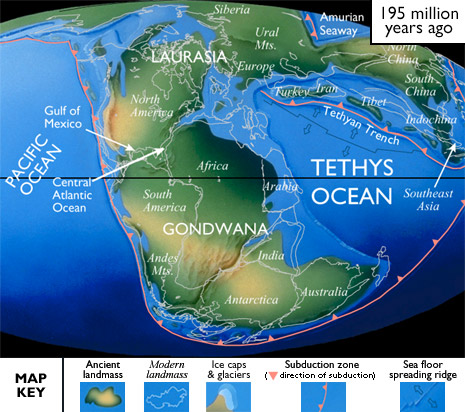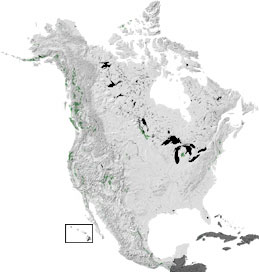the Jurassic - 206 to 144 Million Years Ago
|
|
|
World Paleogeography: In the Early Jurassic, Pangea was breaking up between modern North America, Africa, and South America. By the Middle Jurassic, these rifts were opening up the Central Atlantic Ocean and the Gulf of Mexico formed. Rifting between North America and Eurasia began forming the North Atlantic Ocean while closing the Tethys Ocean. At the same time, volcanic activity began along adjacent margins of East Africa, Antarctica, and Madagascar, where the South Atlantic Ocean would later form. Global climate during the Jurassic was relatively warm and moist over much of northern North America, Eurasia, and Indo-Australian Gondwana. Desert and seasonally wet conditions were present throughout much of Africa, South America, and southern North America. North American Paleogeography: As Pangea rifted apart, North America moved northwest during the Jurassic. The shallow seas that covered the interior of North America retreated to the western edge of the continent. The highlands that dominated eastern North America eroded and large dune deposits formed along the coast, which formed a narrow arm to the east of the modern Canadian Rocky Mountains. Subduction on the western edge of the continent caused frequent volcanic eruptions, forming the igneous rocks in the core of the ancestral Cordilleran. Paleontology: Dinosaurs diversified to fill most of the major ecological niches for land animals. Jurassic dinosaurs reached tremendous sizes: Supersaurus reached over 40 meters in length and Brachiosaurus tipped the scales at about 55 tons. The stegosaurs became abundant, and carnivores such as Allosaurus and Megalosaurus preyed on the abundant herbivores, large and small. Ammonites, coiled and straight-shelled relatives of the modern chambered Nautilus, were major predators among the invertebrates. Ammonite fossils were so abundant and so distinctive in many Jurassic and Cretaceous rocks that they can be used to very finely subdivide these periods. |
|
 |
See the Jurassic in:
Or jump to another period:
|
|
Links to more about the Jurassic
|
Careers | Organizations | Education and Exhibits | Research and Collections | Resources
Careers
Degree and Certificate Programs (showing 1 of 1 listings)
Montana State University- Earth Sciences: Train to be a paleontologist in the MSU Undergraduate and Graduate Paleontology Programs. The Earth Sciences Department at MSU caters to both paleobiology and taphonomy interests.
 Top of List Top of List
Organizations
Parks (showing 1 of 1 listings)
Dinosaur State Park: Visitors' information for Dinosaur State Park in Rocky Hill.
 Top of List Top of List
Colleges and Universities (showing 1 of 1 listings)
Stony Brook University Vertebrate Fossil Preparation Laboratory: Information on the people and research projects at Stony Brook University; also includes general information on fossil preparation techniques.
 Top of List Top of List
Museums (showing 3 of 6 listings)
Fort Worth Museum of Science and History: The Fort Worth Museum of Science and History is a leader in informal science education and provides hundreds of programs aimed at engaging children and families in learning. DinoDig® combines life-sized representations of dinosaurs with a large outdoor discovery area where visitors can become amateur paleontologists and dig for dinosaur bones. There is also a permanent exhibit of Texas dinosaurs featuring several mounted specimens.
Alabama Museum of Natural History: Collections: Experience the natural diversity of Alabama through exhibits from the Age of Dinosaurs, the Coal Age, and the Ice Age. View the Alabama Museum of Natural History's extensive collections of geology, zoology, mineralogy, paleontology, ethnology, history, and photography. Located in historic Smith Hall on the University of Alabama campus, the Museum's mission is to broaden the knowledge of natural sciences and human culture through collections and quality programs of research, instruction, and service; many family-friendly events are offered.
Museum of Western Colorado's Dinosaur Journey: Provides information on visiting the museum, as well as the paleontology of western Colorado and surrounding areas.
 More Museums More Museums
 Top of List Top of List
Government Agencies (showing 2 of 2 listings)
The Cleveland-Lloyd Dinosaur Quarry: This Bureau of Land Management website provides visitor information about the quarry. The quarry is unusual in that the majority of bones are from a single species of carnivorous dinosaur: Allosaurus fragilis.
Dr. John D. Cooper Archaeological and Paleontological Center: The Dr. John D. Cooper Archaeological and Paleontological Center is dedicated to preserving the natural and cultural history of Orange County, California. The Cooper Center, a partnership between O.C. Parks and California State University Fullerton, is committed to the preservation, curation, and management of the fossils and artifacts collected within the County.
 Top of List Top of List
Education and Exhibits
Physical Exhibits (showing 3 of 5 listings)
The Red Gulch Dinosaur Tracksite: This webpage contains information on on the Red Gulch Dinosaur Tracksite, a locality in north-central Wyoming that contains over 1000 tracks of a bipedal, medium-sized dinosaur. Learn about current research at the site, site paleontology, and how to visit the location.
Maryland Science Center Exhibits: This site details information on exhibits at the Maryland Science Center, including Dinosaur Mysteries (featuring a cast T. rex skeleton, models of Maryland's dinosaurs, and other exhibits), Fossil Quest, and TerraLink (highlighting geology and other earth sciences). 
St. George Dinosaur Discovery Site at Johnson Farm: The St. George Tracksite has numerous dinosaur tracks preserved at the bottom of a 3 foot-thick sandstone layer, as well as fossil plants, invertebrates, and fossil fish. From the Utah Geological Survey web site.
 More Physical Exhibits More Physical Exhibits
 Top of List Top of List
Virtual Exhibits (showing 3 of 10 listings)
Dinobuzz: Current Topics Concerning Dinosaurs: Unfortunately, the science of dinosaur paleontology is often obscured by the fantasy that surrounds it. This site from the UC Museum of Paleontology addresses fact vs. fiction on some popular dinosaur-related topics.
Ancient Denvers: Ancient Denvers is a virtual exhibit that highlights 13 reconstructions of ancient Colorado landscapes.
Virtual Museum of Fossils: Geosciences, at Georgia's Valdosta State University, presents an interactive virtual museum of invertebrate and vertebrate fossil specimens. Explore the collection by animal, or by time period from Precambrian to Quaternary. Maps are detailed and include ecosystem distribution. Fossil photographs, many showing multiple views, list information about where the fossil was found, and how it is categorized taxonomically. Some pages feature a drawing of the animal's skeleton showing the fossil bone in red.
 More Virtual Exhibits More Virtual Exhibits
 Top of List Top of List
Research and Collections
Ongoing Research Projects (showing 3 of 7 listings)
Sam Noble Oklahoma Museum of Natural History: On the campus of the University of Oklahoma in Norman. One of the finest university-based museums in the nation, with an active Paleontology research program and extensive collections. 
Database of the Former British Petroleum Microfossil Collection at the NHM, London: In 1991 BP donated to The Natural History Museum their Micropalaeontological Collection. This collection has an extensive geographical and stratigraphic coverage and is a record of BP’s exploration activity since the 1950s. The database hold details of material from over 3,500 individual well runs. The collection includes micropalaeontological assemblage slides and residues; palynological slides and residues and nannofossil slides from wells and outcrop from over 120 countries world-wide.
The Former Aberystwyth Microfossil Collection: This on-line catalogue is designed for university academics and industrial micropalaeontologists who are interested in post Palaeozoic ostracods and foraminifera. Searching this database gives broad information about discrete collections within the Former Aberystwyth University Micropalaeontology Collection that is now housed at the NHM.
 More Ongoing Research Projects More Ongoing Research Projects
 Top of List Top of List
Researchers (showing 2 of 2 listings)
University of Kansas Paleobotanical Collection: Collection of fossil plants currently housed at the University of Kansas.
Paleobotany and Palynology at the Florida Museum of Natural History: The Paleobotany and Palynology Collection at the Florida Museum of Natural History is international in scope, including collections from 47 countries. Systematically the greatest strength of the collection is in Cretaceous-Tertiary angiosperms.
 Top of List Top of List
Resources
Courses and Lectures (showing 1 of 1 listings)
Paleogeography of the Southwestern U.S.: The paleogeography of the southwestern U.S. from 1.8 billion years ago to 10 million years ago. Text and images by Dr. Ron Blakey from Northern Arizona University.
 Top of List Top of List
Field Guides (showing 2 of 2 listings)
Fossil Cephalopods in Utah: A reference to help provide information on the identity, biostratigraphy and location of fossil cephalopods found in the state of Utah.
Dinosaur Footprints and Trackways From the Northeastern U.S.: This webpage details footprints from the Triassic and Jurassic periods of the northeastern United States. Information includes photographs of footprints, along with information on stratigraphic horizon and correlation, age, and taxonomy.
 Top of List Top of List
Databases (showing 3 of 3 listings)
New Mexico Museum of Natural History and Science Web-based Paleo-database Home Page: Search the fossil collections of the New Mexico Museum of Natural History and Science. Listings by Kingdom down to species, era, epoch, group, formation, country, New Mexico county, and map ID. Many listings contain images of the fossils (including all holotypes.) 
The Paleointegration Project: The PaleoIntegration Project (PIP) is facilitating interoperability between global-scale fossil and sedimentary rock databases (e.g. The Paleobiology Database and the Paleogeographic Atlas Project), enabling a greater understanding of the life, geography and climate of our planet throughout the Phanerozoic. Databases can be searched via text and interactive maps, and by any combination of age, location, or content. Results can be plotted on present- and paleo- maps or downloaded for detailed analyses.
Stratigraphy.net: Stratigraphy.Net aims to provide free and open access to geoscientific information and data with special emphasis on the disciplines stratigraphy, paleontology and sedimentology.
 Top of List Top of List
Annotated Bibliographies (showing 1 of 1 listings)
Bibliography of Paleobotany: A bibliographic database of paleobotany including more than 56,000 entries. It also includes references on Antarctic geology and paleontology and citations on Women in Science.
 Top of List Top of List
Maps (showing 1 of 1 listings)
Paleogeography and Geologic Evolution of North America: The images presented here show the paleogeography of North America over the last 550 million years of geologic history.
 Top of List Top of List
History of Paleontology (showing 2 of 2 listings)
Dinosaurios en México: A history of dinosaur discoveries in Mexico.
The Bone Feud: The Bone Feud is a novel about the fossil feud between paleontologists Edward Drinker Cope and O.C. Marsh in the 1870s. It's a fictionalized but well-researched and entertaining take on the story, and is quite suitable for young adults.
 Top of List Top of List
Image Collections (showing 2 of 2 listings)
Michigan Basin Specimen Database: This site showcases Michigan Basin fossils from the private collections of Friends of the University of Michigan Museum of Paleontology and select specimens from the University of Michigan collection, including type specimens.
Royal Ontario Museum dinosaur images: An excellent collection of dinosaur fossil images, many of the fossils represented being from Dinosaur Provincial Park in Alberta. There are also many photos of museum displays and photos taken in the field.
 Top of List Top of List
General Reference (showing 3 of 6 listings)
SkeletalDrawing.com: An anatomical resource for artist and amateurs who want to learn about the science behind restoring prehistoric animals, with an emphasis on dinosaurs. Includes many skeletal reconstructions.
Vida jurásica del Cañón del Huizachal, Tamaulipas: A description of the Early Jurassic vertebrates from this Tamaulipas region.
List of Dinosaurs: This dinosaur listing is data-packed and can be sorted by dinosaur length, weight, time period, etc.
 More General Reference More General Reference
 Top of List Top of List
|
|



